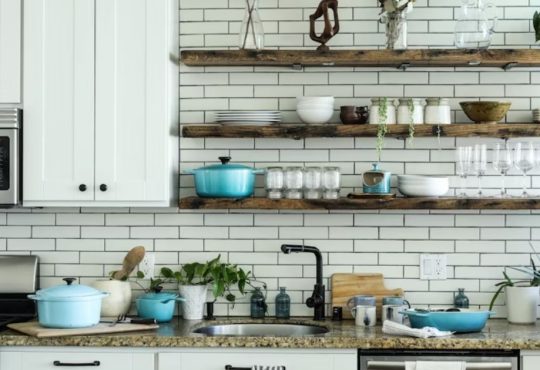Is your kitchen starting to feel more like a chaotic storage closet than a culinary sanctuary? Are you constantly dodging falling Tupperware or rifling through cluttered drawers just to find a whisk? You’re not alone—and the good news is, there’s a smarter way to cook, clean, and store without the mess. Whether you’re working with a compact apartment kitchen or a family-sized space, organizing like a pro is entirely possible with a few strategic upgrades.
A tidy, well-organized kitchen isn’t just about looks—it boosts functionality, saves you time, reduces food waste, and can even make meal prep more enjoyable. In this practical and updated guide for 2025, we’ll walk you through proven tips, clever storage solutions, and current organizational trends to help you reclaim your kitchen and keep it chaos-free for good.
1. Declutter with Purpose: Start Fresh
Before diving into bins and baskets, the most critical step is to declutter ruthlessly but intentionally. Begin by taking everything out of your drawers, cabinets, pantry, and fridge. Yes—everything. This “kitchen reset” gives you a clear view of what you actually use versus what’s just taking up space.
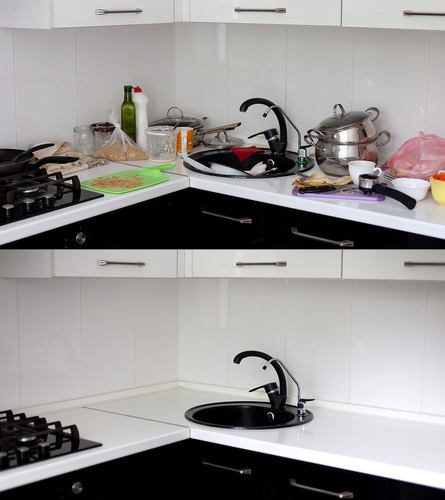
Ask Yourself:
-
Do I use this item at least once a month?
-
Is it a duplicate, damaged, or no longer functional?
-
Does this appliance serve multiple purposes or is it just a space-hogging one-trick pony?
Once you’ve sorted everything, create three categories: Keep, Donate, and Discard. Be honest during this step—sentimental value doesn’t always justify drawer space. If something hasn’t seen the light of day in over six months, it’s likely not essential. Let go of old plastic containers with missing lids, dull knives you’ve stopped using, single-use gadgets, and long-expired pantry items like spices or condiments.
Bonus Tip:
Don’t forget to declutter digital clutter, too—menus stuck on the fridge, expired coupons, or outdated meal planners can add visual noise.
Tip: Sustainability matters more than ever. Many communities now offer eco-friendly donation or recycling services for kitchenware, including programs that repurpose metal, plastic, and even electronics like outdated coffee makers. Check with your local waste management service or apps like Earth911 to responsibly discard items. You can also explore local “Buy Nothing” groups or neighborhood swaps to give gently used tools a second life.
2. Categorize and Zone Like a Pro Chef
Professional chefs thrive in kitchens where everything has its place, and you can recreate that same efficiency with a few smart zoning strategies. Zoning isn’t just about tidiness—it helps create a logical flow that aligns with how you cook, clean, and prep daily.’
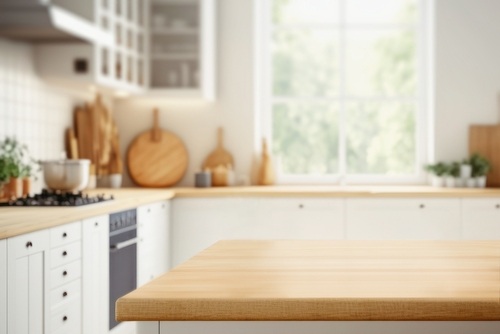
Create Functional Zones:
-
Prep Zone – Cutting boards, knives, mixing bowls, peelers, and measuring cups should all be stored near your primary prep surface. Ideally, keep this zone close to the sink for easy rinsing.
-
Cooking Zone – Store pots, pans, spatulas, ladles, oils, and frequently used spices near the stovetop or oven. This setup allows you to grab essentials mid-recipe without breaking your stride.
-
Baking Zone – Mixing tools, rolling pins, flour, sugar, baking trays, and measuring tools should be grouped together. If you bake often, consider keeping this zone near a clear countertop for rolling dough or decorating treats.
-
Cleaning Zone – Dish soap, sponges, scrub brushes, trash bags, dishwasher pods, and towels belong near the sink or dishwasher. A pull-out trash can or recycling bin nearby enhances the workflow.
-
Coffee/Breakfast Station – Dedicate a space to mugs, coffee pods, teas, cereals, and quick-grab breakfast items. Keeping the toaster or coffee maker here turns this into a self-serve mini café for busy mornings.
Use clear bins, drawer organizers, or labeled containers to group zone-specific items together. This system not only creates visual order but also cuts down on time spent hunting for tools or ingredients during busy moments.
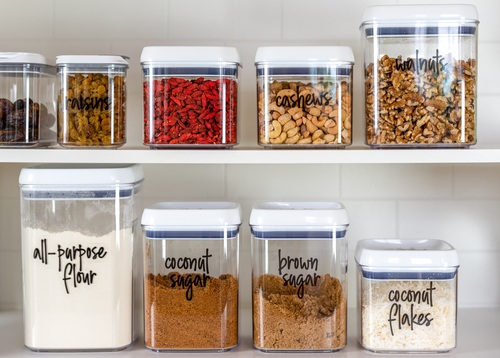
Pro Tip: Consider color-coded bins or labels for each zone. In shared households or busy families, this simple visual cue helps everyone return items to the right place—reducing clutter and confusion over time.
3. Maximize Vertical Space: Go Up, Not Out
With kitchens becoming more compact—especially in modern urban living spaces—using your vertical real estate is a game changer. When floor and counter space is limited, thinking vertically helps you store more without adding bulk or clutter.

Clever Ways to Use Your Wall & Cabinet Space:
-
Install floating shelves above your sink or countertops to hold everyday dishes, jars, or decorative pieces like plants or cookbooks. It adds both function and personality to your kitchen.
-
Add a pegboard wall (à la Julia Child) to hang utensils, pans, oven mitts, or even colanders. It keeps tools within reach and frees up drawer space.
-
Use adhesive hooks or magnetic strips inside cabinet doors for storing pot lids, scissors, bottle openers, or dish towels. This turns hidden spaces into hardworking storage.
-
Hang a pot rack from the ceiling or over a kitchen island to store your most-used pots and pans. This not only saves cabinet space but adds a professional kitchen feel.
-
Try over-the-door organizers on pantry or utility closet doors to hold snacks, cleaning products, wraps, or even spices. It’s especially useful for maximizing small pantry spaces.
Storage Trend: Modular, magnetic shelving systems are trending for their flexibility and ease of use—especially for renters or small homes. Brands like Yamazaki Home, Umbra, and newer startups offer sleek, no-drill vertical solutions that can be rearranged as your needs evolve.
4. Smart Storage Solutions for a Seamless Flow
It’s not just about where you store things—it’s about how you store them. A well-organized kitchen flows with your daily habits, making cooking and cleaning feel effortless. By choosing smart storage tools that support your routine, you reduce stress and keep your space looking sleek and streamlined.

Top Smart Storage Tools:
Drawer dividers: Use adjustable dividers or bamboo trays to keep utensils, cutlery, and even those odds-and-ends (“junk drawer” items) in order. Group similar items together for easy access and cleaner visuals.

Spice drawer inserts or pull-out racks: Alphabetize spices or group them by cuisine (Italian, Indian, etc.). Keeping them visible and upright helps prevent duplicates and makes flavoring meals quicker.
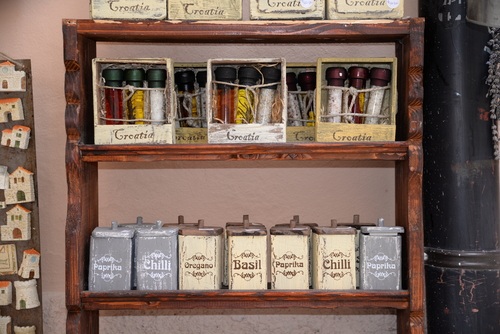
Pull-out pantry shelves: Perfect for deep or narrow cabinets. These shelves slide out so you can see and grab everything without knocking over other items.
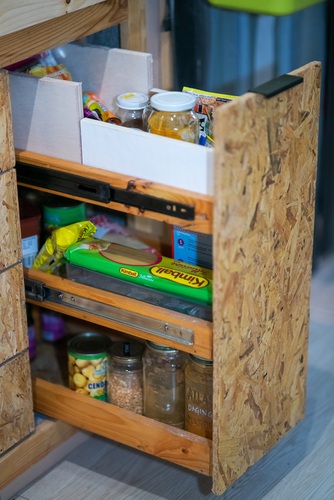
Clear stackable bins: Ideal for fridge, freezer, or pantry organization. Use them to store snacks, sauces, baking ingredients, or produce. The clear design lets you see what’s inside instantly.
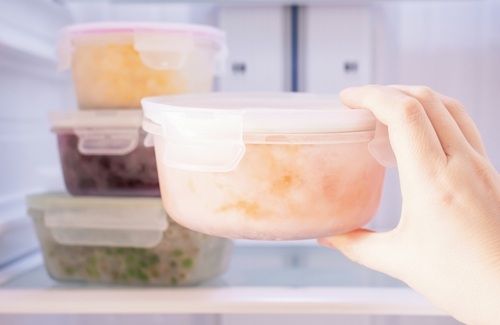
Under-sink caddies: Utilize sliding, tiered, or pull-out organizers to store dish soap, garbage bags, sponges, or cleaners in a typically overlooked space.
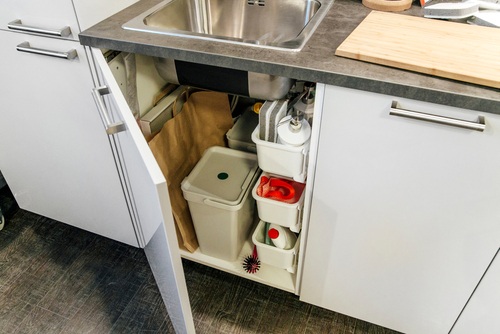
Expandable shelf risers: These help you use vertical space inside cabinets, doubling the surface for storing plates, mugs, canned goods, or dry food containers.
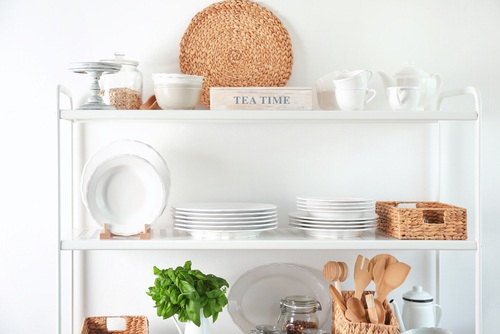
Pro Tip: Add QR code labels to pantry bins, spice jars, or storage containers. Paired with inventory apps like Pantry Check, Sortly, or Out of Milk, you can track what you have, what’s expiring soon, and what to restock—reducing waste and saving time on shopping trips.
5. Embrace Tech and Automation Where It Helps
Modern kitchens are smarter than ever, and even small tech upgrades can go a long way in simplifying your daily routines and reducing clutter. By integrating the right gadgets, you can streamline everything from meal planning to inventory tracking—saving time, reducing waste, and boosting convenience.
Useful Kitchen Tech in 2025:
-
Smart fridges can now track groceries, suggest recipes based on what’s inside, and even alert you when items are about to expire. Some models sync with grocery apps to help automate your shopping list.
-
Motion-sensor lighting inside cabinets or deep drawers improves visibility, especially in hard-to-reach spaces. Great for night-time cooking or when your hands are full.
-
Label printers (like Brother’s P-Touch or Cricut Joy) now sync with apps that let you create custom labels for bins, containers, and pantry jars. Organized labels mean faster access and fewer spills or mix-ups.
-
Voice-controlled devices such as Alexa, Google Assistant, or Siri can help you follow step-by-step recipes, set timers, convert measurements, or update your shopping list—all hands-free while you cook.
-
Smart plugs or timers allow you to control small appliances remotely or schedule them to turn on/off—perfect for coffee makers or slow cookers.
Tip: Keep a tablet or smart display (like the Echo Show or Google Nest Hub) mounted on a wall or propped on the counter. Use it to display your weekly meal plan, browse recipes, watch how-to videos, or check what’s in your pantry at a glance. It turns your kitchen into a true command center.
6. Keep the Counters Clear: Less is More
Your countertops are prime real estate in the kitchen, and clutter can quickly make the space feel smaller and more chaotic. Keeping them clear not only improves functionality but also makes your kitchen easier to clean and more visually relaxing. The golden rule? Only keep out what you truly use every day.
Items Worth Keeping Out:
-
Coffee machine or kettle – If you start your mornings with these, keep them ready to go in your beverage station.
-
Toaster or air fryer – Leave out only if they’re used daily or part of your core cooking routine.
-
Knife block or magnetic strip – Essential tools should be accessible, but consider wall-mounted strips to free up counter space.
-
A decorative bowl – Use it for fruit, fresh herbs, or even garlic and onions—it adds both function and a natural touch.
Everything else—blenders, mixers, waffle makers—should be stored in cabinets or drawers based on how frequently you use them. Weekly-use items should be within arm’s reach, while monthly or seasonal gadgets can go on top shelves or in utility closets.
Design Tip: The Japandi (Japanese-Scandinavian) aesthetic continues to trend, emphasizing simplicity, warmth, and functionality. Invest in concealed storage, handle-free cabinetry, and integrated appliances to maintain clean lines and reduce visual noise. Neutral color palettes with natural wood or stone textures also enhance the minimalist look while keeping the space inviting.
7. Schedule Regular Kitchen Maintenance
Once your kitchen is organized, keeping it that way comes down to consistent habits and a manageable maintenance routine. Even the most beautifully arranged kitchen can fall into disarray without regular upkeep. The key is to build small tasks into your weekly and monthly schedule so they become second nature.
Weekly Maintenance Plan:
-
Wipe down all surfaces – Include countertops, cabinet fronts, backsplash, and appliance exteriors to prevent grime buildup.
-
Do a quick fridge check – Toss expired items, wipe sticky spots, and reorganize shelves as needed.
-
Restock key staples – Check your inventory of essentials like flour, spices, canned goods, pasta, and coffee. Add missing items to your shopping list.
-
Vacuum/mop the floors – Pay special attention to high-traffic areas near the stove, sink, and fridge where crumbs and spills accumulate quickly.
Monthly Maintenance:
-
Declutter a drawer or cabinet – Rotate through one section each month to keep clutter from creeping back in. Check for duplicates, worn-out tools, or forgotten gadgets.
-
Clean small appliances – Wipe down or deep-clean your microwave, air fryer, coffee maker, kettle, or toaster to remove buildup and prolong their lifespan.
-
Reassess storage systems – If you find yourself constantly digging for items or leaving things on the counter, it may be time to adjust your zones or rearrange for better flow.
Pro Tip: Use a shared digital calendar or task app like Todoist, Cozi, or Google Calendar to assign small cleaning tasks throughout the week. This keeps the workload manageable and encourages the whole household to take part in maintaining a clutter-free space.
8. Personalize Your Space
Functionality is key, but your kitchen should also reflect your personality and lifestyle. After all, it’s not just a place to cook—it’s where you gather, connect, and create memories. Personal touches add warmth and character, making the space truly your own.
Add Personal Touches:
-
A magnetic board or chalkboard for grocery lists, handwritten recipes, family notes, or reminders. It’s both decorative and practical, especially for busy households.
-
Open shelving to display your favorite mugs, colorful dishware, or vintage cookbooks. Mixing practical items with decor creates visual interest without clutter.
-
A small herb garden on the windowsill or countertop with basil, mint, or rosemary brings life and aroma into the kitchen—and adds a touch of freshness to your meals.
-
Mood lighting under cabinets, around toe-kicks, or above counters helps set the tone. Choose dimmable LEDs or smart bulbs for adjustable ambiance, whether you’re cooking or hosting.
Design Insight: According to Houzz’s 2025 Kitchen Trends Report, more homeowners are embracing personalization over perfection. Whether it’s a bold backsplash, a statement light fixture, or family art on the fridge, your kitchen should make you feel at home. Embrace design choices that reflect your style—even if they’re unconventional.
Kitchen Organization is A Way of Living Today
An organized kitchen doesn’t require a full remodel or a massive budget. With a little planning, intentionality, and ongoing upkeep, you can transform your space into a functional, stylish, and stress-free zone. Think of your kitchen as a command center for daily living—when everything has a home, it becomes easier (and more enjoyable) to cook, clean, and connect.
So whether you’re battling clutter in a tiny apartment or streamlining a large family kitchen, take it one step at a time. Start with what you have, use the space smartly, and keep systems simple enough to stick with. A calm, clutter-free kitchen isn’t just a dream—it’s a daily reality waiting to happen. And once you feel the ease of a truly organized kitchen, you’ll never go back.


